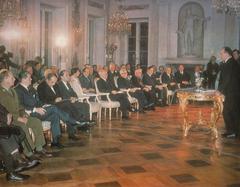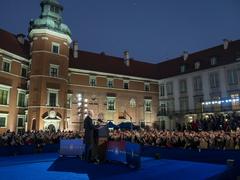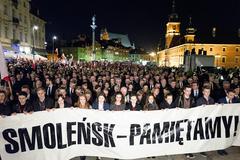
The Royal Castle in Warsaw: Visiting Hours, Tickets, and In-Depth Visitor Guide
Date: 14/06/2025
Introduction
The Royal Castle in Warsaw stands as one of Poland’s most significant historical and cultural monuments. From its medieval beginnings to its role in the nation’s political and artistic evolution, the castle offers a compelling journey through centuries of Polish history. This comprehensive guide provides detailed insights into the castle’s history, architecture, collections, and practical information for visitors—including up-to-date visiting hours, ticket details, accessibility, and travel tips (medievalheritage.eu, whc.unesco.org).
Contents Overview
- Medieval Origins and Early Development
- Renaissance and Baroque Transformations
- Seat of Polish Democracy and Enlightenment
- Decline, Partitions, and Wartime Destruction
- Post-War Reconstruction and UNESCO Recognition
- Visitor Information: Hours, Tickets, and Accessibility
- Highlights and Must-See Features
- Guided Tours and Visitor Tips
- Nearby Attractions and Facilities
- Frequently Asked Questions (FAQ)
- Conclusion and Final Recommendations
Medieval Origins and Early Development
The site of the Royal Castle dates to the late 13th century, when a fortified stronghold was built by the Dukes of Mazovia. Initially constructed from timber atop the Vistula River escarpment, the castle’s location provided strategic natural defenses. By the early 14th century, brick structures such as the Great Tower were added, marking the transition to a more permanent and formidable residence. Over the next two centuries, the complex expanded with new wings, towers, and the Minor Court, which often housed princely regents (medievalheritage.eu).
Renaissance and Baroque Transformations
With the extinction of the Masovian dynasty in 1526, the castle became a royal residence under the Polish crown. Renaissance renovations led by Italian architects like Giovanni Battista Quadro and Jacopo Pario introduced symmetrical courtyards and refined facades. Its most significant transformation came during the reign of King Sigismund III Vasa, who moved the Polish capital to Warsaw and initiated a Baroque expansion, unifying earlier structures into a grand five-winged palace with a central courtyard (medievalheritage.eu, Wikipedia). Later, Neoclassical elements were added by architect Jakub Fontana, giving the southern wing its stately rhythm and monumental presence.
Seat of Polish Democracy and Enlightenment
The Royal Castle played a pivotal role in Poland’s political life. As the seat of the Sejm (parliament), it was the venue for the adoption of the Constitution of 3 May 1791—the first modern constitution in Europe and the second worldwide (whc.unesco.org). This event cemented the castle’s status as a symbol of Polish statehood, democracy, and progressive values.
Decline, Partitions, and Wartime Destruction
After the partitions of Poland, the castle lost its royal function and became the residence of tsarist governors. Following Poland’s independence in 1918, it served as the presidential residence. World War II brought catastrophic destruction: the castle was bombed and ultimately razed by Nazi forces after the Warsaw Uprising in 1944, as part of a campaign to erase Polish cultural heritage (whc.unesco.org).
Post-War Reconstruction and UNESCO Recognition
Driven by national determination and public fundraising, reconstruction began in the 1970s, guided by historical records, Canaletto’s paintings, and surviving fragments (europeanribbon.eu). The castle reopened to the public in 1984. In 1980, the Royal Castle and Warsaw’s Old Town were inscribed as a UNESCO World Heritage Site, honoring their outstanding universal value and exemplary restoration (whc.unesco.org, culture.pl).
Visitor Information: Hours, Tickets, and Accessibility
Visiting Hours
- Open Tuesday–Sunday, typically from 10:00 AM to 6:00 PM (extended to 8:00 PM on Fridays).
- Closed Mondays and on select public holidays.
- Last admission is usually 30 minutes before closing.
- Always check the official Royal Castle website for current schedules.
Tickets and Admission
- Standard admission: ~30 PLN.
- Discounts for students, seniors, children, and groups.
- Free entry on select days, such as Wednesdays and International Museum Day.
- Tickets can be purchased online (recommended to avoid queues) or at the ticket office (zamek-krolewski.pl).
- Guided tours and audio guides are available for an extra fee (Sightseeing Warsaw).
Accessibility
- Most exhibition spaces are accessible to visitors with mobility challenges (elevators, ramps).
- Family-friendly features include stroller access and educational programs.
- Visitor information and signage are in Polish and English; audio guides are offered in multiple languages.
Highlights and Must-See Features
- Senators’ Hall: Where the 3 May Constitution was adopted; richly decorated with portraits of Polish monarchs (go2warsaw.pl).
- Royal Apartments: Featuring the Prospect Room with Canaletto’s landscapes, the Audience Chamber, and the royal chapel (theuniquepoland.com).
- Senate Apartments: Including the Ballroom, Knights Hall, Throne Room, and Marble Room, adorned with historical paintings and sculptures.
- Canaletto Room: Showcasing 22 cityscapes by Bernardo Bellotto, vital references for post-war reconstruction.
- Rembrandt Paintings: “Girl in a Picture Frame” and “Scholar at His Writing Table” form part of the castle’s celebrated art collection.
- Royal Gardens: Recently restored, offering tranquil green spaces with views over the Vistula River (Travelling Camera).
Guided Tours and Visitor Tips
- Guided tours are highly recommended and available in several languages, offering deeper insights into the castle’s history and collections.
- Audio guides are ideal for independent visitors.
- Best times to visit: Weekdays and mornings are less crowded; Wednesdays are free but busier.
- Photography: Non-flash photography is allowed in most areas, with some restrictions in special exhibitions.
- Plan at least 2 hours for a comprehensive visit.
Nearby Attractions and Facilities
- Castle Square (Plac Zamkowy): The vibrant entry to Old Town, home to Sigismund’s Column.
- Warsaw Old Town: UNESCO-listed, with cafes, shops, and historical sites (thecrazytourist.com).
- Royal Route: Historic thoroughfare linking the castle to other royal landmarks.
- Amenities: Cloakroom, restrooms on each floor, museum shop, and café.
Transport:
- Accessible by tram, bus, and metro (nearest station: Ratusz Arsenał, 10 minutes’ walk).
- Limited parking nearby; public transport is recommended.
Frequently Asked Questions (FAQ)
Q: What are the Royal Castle’s opening hours?
A: Open Tuesday–Sunday, 10:00–18:00 (Fridays until 20:00). Closed Mondays.
Q: How do I buy tickets?
A: Online via the official website or at the entrance.
Q: Are there free admission days?
A: Yes, usually on Wednesdays and select holidays.
Q: Is the castle accessible for those with mobility challenges?
A: Yes, elevators and ramps serve most public areas.
Q: Are guided tours available?
A: Yes, in multiple languages. Booking in advance is advised.
Q: Can I take photos inside?
A: Non-flash photography is permitted in most areas.
Conclusion and Final Recommendations
The Royal Castle in Warsaw is a living monument to Poland’s turbulent yet inspiring history, embodying resilience, artistic achievement, and democratic ideals. Its meticulously restored interiors, impressive art collections—including Rembrandt and Canaletto masterpieces—and dynamic cultural programming offer something for every visitor.
For the best experience:
- Check the official Royal Castle website for current hours and ticket availability.
- Book your tickets and tours in advance, especially during peak seasons.
- Start your visit with the cellar exhibition, “From Destruction to Reconstruction,” for vital historical context (Kids in the City).
- Enhance your visit with guided or audio tours.
- Explore the surrounding Old Town and Royal Route for a full immersion in Warsaw’s heritage.
Download the Audiala app for guided audio tours and up-to-date event information, and follow the castle’s social media for news and special programs. The Royal Castle is not just a museum—it is a testament to the enduring spirit and cultural pride of Poland.
Sources and Useful Links for Further Information
- Royal Castle Warsaw: History, Visiting Hours, Tickets, and Travel Tips, 2025, medievalheritage.eu (https://medievalheritage.eu/en/main-page/heritage/poland/warszawa-royal-castle/)
- Royal Castle Warsaw: Visiting Hours, Tickets, and Historical Significance, 2025, culture.pl (https://culture.pl/en/work/the-royal-castle-in-warsaw)
- Royal Castle Warsaw: Visiting Hours, Tickets, and Historical Significance, 2025, warsawvisit.com (https://warsawvisit.com/royal-castle/)
- Visiting the Royal Castle in Warsaw: Hours, Tickets, and Historical Highlights, 2025, go2warsaw.pl (https://go2warsaw.pl/en/rediscover-warsaw-in-2025/)
- Royal Castle Warsaw Visiting Hours, Tickets, and Visitor Guide to Warsaw Historical Sites, 2025, kidsinthecity.pl (https://kidsinthecity.pl/listing/what-to-do-in-warsaw-the-royal-castle-in-warsaw/)
- Royal Castle Warsaw Visiting Hours, Tickets, and Visitor Guide to Warsaw Historical Sites, 2025, thecrazytourist.com (https://www.thecrazytourist.com/25-best-things-to-do-in-warsaw-poland/)
- Royal Castle Warsaw: History, Visiting Hours, Tickets, and Travel Tips, 2025, whc.unesco.org (https://whc.unesco.org/en/list/30/)
- Royal Castle Warsaw: Visiting Hours, Tickets, and Historical Significance, 2025, zamek-krolewski.pl (https://www.zamek-krolewski.pl/en)
- The Royal Castle in Warsaw: A Comprehensive Visitor’s Guide, 2025, theuniquepoland.com (https://theuniquepoland.com/warsaw-travel-guide-everything-you-need-to-know-before-visiting)




































































































































































